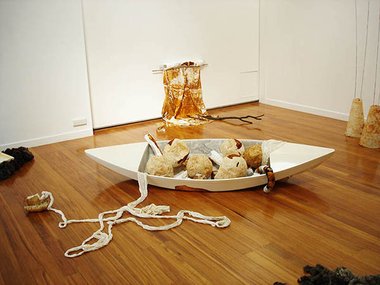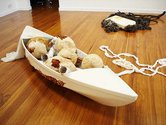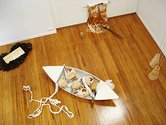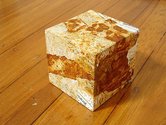Andrew Paul Wood – 28 March, 2011
The central feature is a small boat of painted plywood - like an abandoned thing, anchored to a piece of marble by a swathe of silken fabric - with a cargo of fragile-looking paper balloons, paper covered tin cubes, and plaster bandaged wire tubes in its interior lined with torn and pasted pages from the French newspaper 'Le Monde Diplomatique'.
Pauline Rhodes’ installation Stains/Tears was due to open at the Jonathan Smart Gallery on the evening of February 22, 2011. Of course, this was made impossible by the earthquake that ripped through the city that afternoon, incidentally destroying Rhodes’ private archive and over thirty years of practice documentation, giving what was already an atmospheric piece an even greater poignancy with its slabs of masonry and branches like fallen trees. The installation has held up rather well, though the loss of Rhodes’ archive is a tragedy. Rhodes photographs many of her outdoor installations before removing the components, and she and the camera in many instances may be the only ones to see the physical work.
We of the Christchurch art scene are delighted that some galleries are muddling on through, and despite the Mad Max performance around the devastated CBD to get to the gallery in Linwood, it was well and truly worth it. Smart has already suffered the destruction of a gallery with the September 2010 quake. We understand that Page Blackie Gallery in Wellington are handing over their gallery to Smart for an exhibition in May. The North Island has been unflinchingly generous to the Garden City in its hour of need. We are grateful.
Rhodes is a senior practitioner of the conceptual installation, and many a younger artist could learn from her patience of deployment and thoroughness of ideation. Not only does she push the envelope, but she actually goes to the trouble of purchasing the intellectual stamps as well. Despite her humility and private nature, she is easily one of the most significant artists practicing in New Zealand, certainly in Canterbury. Her work is intensely humanist, concerned with communication and organic change - bringing the outdoors inside, and the indoors out, making experience of both an intimate experience.
The wall text describes the installation in terms of “sets”, implying something theatrical, dramatic. The usual Rhodian leitmotifs are there: charcoal, rust, paper - suggestive of Joseph Beuys’ materials of memory and metaphor. Charcoal-blackened branches from gum trees, thrice in association with a foliage, or nimbus, of black sheep’s fleece. The fleece also supports slabs of Oamaru limestone, counterpointing heavy and light, soft and hard, light and dark. These assemblages are emphatic and frame the composition. Overseeing are what Rhodes calls “watchers” - four iron rods forged and twisted into curlicues at the top, covered with rice paper and held in place by steel stands hidden with rust-stained skirts of rice paper.
The making involved is a complex one. The rust stains often aspire to an almost painterly system of gestures, but are achieved by an alchemical process of trial, error and environmental control. That is essential to Rhodes’ practice, as the wall text says: “[Rhodes] has also described the preparation process for installation as one of discovery, involving putting things together into new relationships, associative and reactive. She seeks the connectedness of ideas and things through meetings of chaos and chance. Matter filters into materials and organic form.” The impression of abjection serves only to enhance the fleeting, frail and ephemeral nature of Rhodes’ work - a kind of abstract memento mori.
The central feature is a small boat of painted plywood - like an abandoned thing, anchored to a piece of marble by a swathe of silken fabric - with a cargo of fragile-looking paper balloons, paper covered tin cubes, and plaster bandaged wire tubes in its interior lined with torn and pasted pages from the French newspaper Le Monde Diplomatique. Is this a symbol of transition, something autobiographical, an art-historical reference or even something related to Canterbury? The latter comes to mind when recalling that the provincial coat of arms contains heraldic fleeces, ships, and sheaves of wheat which Rhode’s watchers could possibly, when squinted at, resemble. But this is just evidence that an abstract installation can have anything that the viewer deems appropriate read into it.
The Christchurch community is extremely fortunate to still have art to engage with at this difficult, trying time. We are doubly fortunate that it is of this calibre.
Andrew Paul Wood









 Advertising in this column
Advertising in this column Two Rooms presents a program of residencies and projects
Two Rooms presents a program of residencies and projects



This Discussion has 0 comments.
Comment
Participate
Register to Participate.
Sign in
Sign in to an existing account.